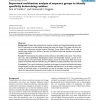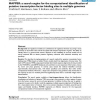21 search results - page 1 / 5 » Neural Networks for Determining Protein Specificity and Mult... |
ISMB
1994
13 years 6 months ago
1994
Weuse a quantitative definition of specificity to developa neural networkfor the identification of commonprotein binding sites in a collection of unaligned DNAfragments. Wedemonst...
RECOMB
2007
Springer
14 years 5 months ago
2007
Springer
Transcription factor (TF) binding to its DNA target site is a fundamental regulatory interaction. The most common model used to represent TF binding specificities is a position spe...
BMCBI
2007
13 years 5 months ago
2007
Background: Proteins that evolve from a common ancestor can change functionality over time, and it is important to be able identify residues that cause this change. In this paper ...
BMCBI
2005
13 years 4 months ago
2005
Background: Cis-regulatory modules are combinations of regulatory elements occurring in close proximity to each other that control the spatial and temporal expression of genes. Th...
BMCBI
2006
13 years 5 months ago
2006
Background: Molecular evolutionary studies of noncoding sequences rely on multiple alignments. Yet how multiple alignment accuracy varies across sequence types, tree topologies, d...


